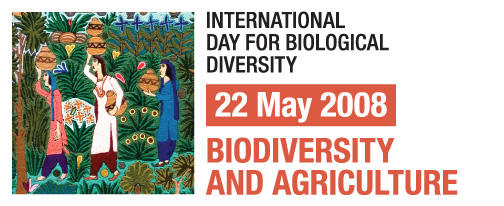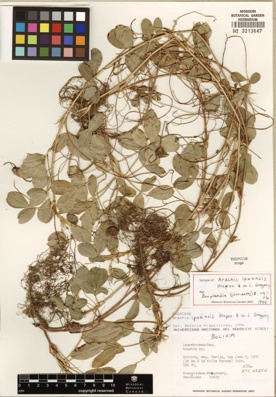
Every year since 2002 there’s been an International Day of Biodiversity, each time with a different theme. This year the celebrations on May 22 will revolve around “Biodiversity and Agriculture.” We’ll have to think of something special to do here…
Agrobiodiversity is crops, livestock, foodways, microbes, pollinators, wild relatives …

Every year since 2002 there’s been an International Day of Biodiversity, each time with a different theme. This year the celebrations on May 22 will revolve around “Biodiversity and Agriculture.” We’ll have to think of something special to do here…
That last but one post of Jeremy’s got me thinking. How do we find out if Arachis ipaensis is still at that locality? I mean, short of mounting a fully-fledged expedition of groundnut experts at vast expense, that is. One way might be to ask a local person to check for us. Ok, a wild peanut species might not be the best thing to try this with, but you get the idea. Problem is, how do we identify a local person who knows that area?
Then I remembered something Jeremy sent me recently. WikiLoc is a website to which you can upload your favourite walk or cycle ride as a GPS track. You can then view all these in a number of different ways, including in Google Earth. So I gbiffed (sensu Cherfas, 2008) the localities of wild Arachis species and viewed them in Google Earth together with all the tracks from South America available on WikiLoc.
Well, of course, none of the trails was anywhere near the locality of A. ipaensis. But I did find others that came near — or very near — the localities of other species. Check this one out, for example:
It’s a 32 km circuit around Piribebuy in Paraguay, and it was uploaded by someone called Yagua. It takes about 4 hours to walk it. And it so happens that a specimen of Arachis glabrata was collected along Yagua’s favourite trail, around its southeastern corner:

Now, I don’t think A. glabrata is a particularly significant component of the groundnut genepool, but say, for the sake of argument, that it had been. Couldn’t we ask Yagua to keep an eye on it for us? Multiply by the more than 10,000 tracks on WikiLoc and pretty soon you’re talking about a real global network of agrobiodiversity monitors. But maybe we should test the idea out with a somewhat more — ahem — charismatic plant. And imagine if germplasm collectors start adding their tracks to WikiLoc.
Let us not forget, that before The Origin and natural selection there was artificial selection; in other words, plant and animal breeding, mostly in the service of agriculture.
So, Happy Birthday, Charles Darwin. There’s a whole lot of stuff going on today, which has quite a history.
One more substantive link will do, to the Biodiversity Heritage Library‘s entry for today.
Oh no! Waylaid by Wikipedia I discover that today is also the anniversary of the Battle of the Herrings, which took place in 1429. Fishy, huh?
A propos of the peanut’s past, it just so happens that one of the great peanut people of the world (as immortalized in this specific epithet) now lives just down the corridor at work. So I showed him that article. He was well pleased to see it, explaining for me how it confirmed previous ideas based on crossing and geography. Then, on the way out, he casually mentioned that seeds of one of the ancestors had been collected only once, and that it had never been found again.
“It’s probably extinct,” he said.
 Well, that certainly adds a certain spice to an otherwise moderately routine story, I thought. So at the first opportunity I asked Luigi, who understands these things, to gbif A. ipaensis for me. ((Webbies are well aware of the verb “to google.” To GBIF is not yet a verb, as far as I can discover. Probably not in the present tense, and definitely not in the past. I hereby lay claim to it.)) Quick as a flash, he sent me arachis.kml, a KML file for Google Earth. There were precisely two entries, one for the type specimen at the Missouri Botanic Gardens and one for an accession in the USDA genebank. To me, they looked suspiciously located, on exactly the same latitude but about 45.5 km apart. And while the USDA’s specimen was reasonably near to a stream, Missouri’s was nowhere near water that I could see.
Well, that certainly adds a certain spice to an otherwise moderately routine story, I thought. So at the first opportunity I asked Luigi, who understands these things, to gbif A. ipaensis for me. ((Webbies are well aware of the verb “to google.” To GBIF is not yet a verb, as far as I can discover. Probably not in the present tense, and definitely not in the past. I hereby lay claim to it.)) Quick as a flash, he sent me arachis.kml, a KML file for Google Earth. There were precisely two entries, one for the type specimen at the Missouri Botanic Gardens and one for an accession in the USDA genebank. To me, they looked suspiciously located, on exactly the same latitude but about 45.5 km apart. And while the USDA’s specimen was reasonably near to a stream, Missouri’s was nowhere near water that I could see.
 Luigi quickly confirmed that the Mo specimen, collected in 1971 and thus well pre-GPS, was probably in the wrong place; OK. These things happen. Then he was on the IM again, telling me that I could look at an image of the type specimen (that’s it over there) and that the USDA specimen was “unavailable”.
Luigi quickly confirmed that the Mo specimen, collected in 1971 and thus well pre-GPS, was probably in the wrong place; OK. These things happen. Then he was on the IM again, telling me that I could look at an image of the type specimen (that’s it over there) and that the USDA specimen was “unavailable”.
“What’s that mean?”
“Could be dead. Could be regenerating and they don’t have stock.”
“Bummer.”
“Yeah.”
And then we went about our independent business for a while until he sent “Can you imagine how hard that would have been 10 years ago? Or even 5?”
And it’s true. A few quick clicks, some very spiffy intertube tools, and we had the kind of information that could have taken months to gather back in the day. Information is going to be the life and death of efforts to conserve and make use of agrobiodiversity. And easy though it was to find out a bit about A. ipaensis, we don’t really know anything about the plant itself. Is it drought tolerant? Disease susceptible? Fertile with A. hypogaea? Got good genes?
And, in other Arachis news:
That’ll do, for now.
We only nibbled it here, but Andy over at Ecosystems and Poverty has a somewhat longer post about the new book on the “lost fruits” of Africa. Maybe we should have given it more respect. The previous books in the series, which covered Africa and the Andes, are very good indeed.